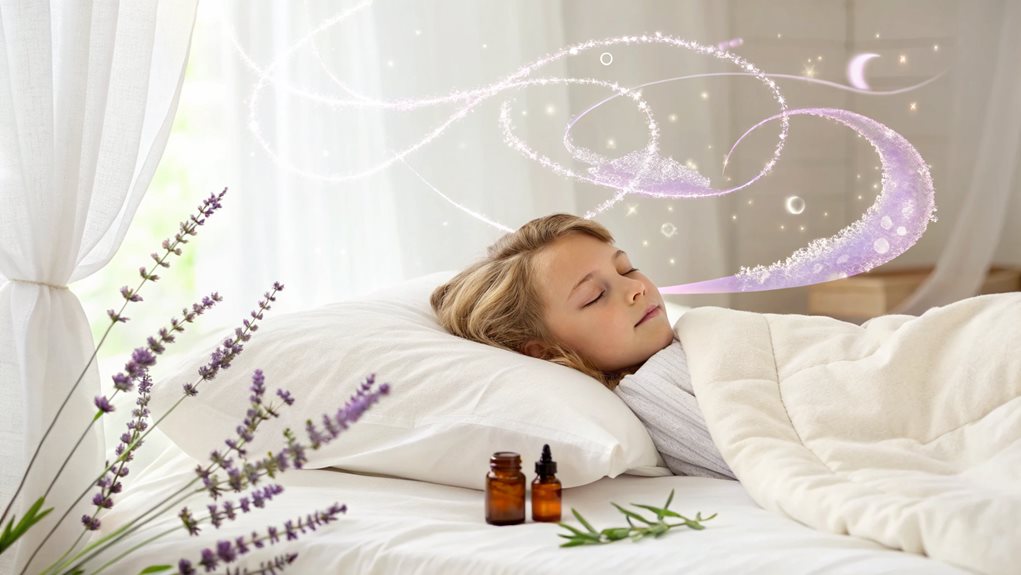Table of Contents - click here
Toggle
Growing pains naturally respond to gentle essential oil massage using properly diluted blends like Caresse. Applied 15-30 minutes before bedtime, this clinical aromatherapy approach provides safe, effective relief for children ages 3+ without pharmaceutical concerns. Roman chamomile and peppermint work synergistically to reduce muscle tension and inflammation.
While pediatricians often recommend over-the-counter pain relievers, many parents seek natural approaches that honor their child’s developing system while providing real relief. Caresse essential oil blend represents exactly this philosophy: a professionally formulated solution that combines traditional healing wisdom with modern safety standards.
This guide transforms those midnight episodes of pain into opportunities for healing connection, while providing the knowledge to use therapeutic aromatherapy safely and effectively with children.
Growing pains affect children in predictable patterns, typically striking between ages 3-5 and 8-12, with episodes occurring most frequently during evening hours and lasting 10-30 minutes on average.

Understanding Your Child’s Growing Pains
The Real Science Behind Growing Pains
Growing pains don’t actually correlate with growth spurts—medical research reveals a different story entirely. These episodes likely stem from muscle fatigue accumulated during active days, potential connections to restless leg syndrome, or heightened sensitivity to normal muscle tension.
Growing pains typically affect children during two distinct phases of development. The first wave emerges between ages 3-5, often coinciding with increased mobility and playground activities. The second phase occurs between ages 8-12, when children engage in more structured sports and physical activities.
Understanding this timing helps recognize that a child’s pain represents a normal developmental experience rather than a concerning medical condition. Episodes usually occur during late afternoon or evening hours, often disrupting family sleep patterns and leaving parents searching for effective comfort measures.
Common Signs and Symptoms
Growing pains present distinctive characteristics that help differentiate them from other childhood discomforts. The pain typically manifests as aching or throbbing sensations in leg muscles, particularly targeting the calves, thighs, or areas behind the knees.
Unlike joint-related issues, growing pains affect soft tissues and muscles rather than bones or joints. The discomfort usually occurs on both sides of the body simultaneously, rarely presenting with visible swelling, redness, or warmth that might indicate inflammation.
Episodes commonly strike during evening hours or nighttime, often waking children from peaceful sleep. These sessions typically last between 10-30 minutes, though duration varies significantly between individual children.
Growing pains occur sporadically over several months or years, with comfortable, pain-free intervals between episodes. The discomfort generally responds well to gentle massage, heat application, and comforting measures—characteristics that distinguish growing pains from more serious conditions requiring medical intervention.
Why Choose Natural Pain Management for Children
Natural remedies offer compelling advantages over conventional medications, especially for recurring childhood issues like growing pains.
Benefits of Aromatherapy Approaches
Pharmaceutical concerns parents often have:
- Frequent medication use in developing children
- Potential side effects with regular administration
- Limited addressing of emotional distress
Natural advantages families appreciate:
- Multi-layered relief addressing physical and emotional aspects
- Sleep-promoting benefits beyond pain management
- Empowerment for active parental involvement
- Lifetime wellness habits established early
Natural pain management strategies also empower parents to take an active role in their child’s comfort while teaching valuable self-care practices. Children who experience the soothing benefits of essential oil massage often develop positive associations with natural healing approaches that serve them throughout their lives.
The holistic nature of natural remedies addresses not just physical discomfort but also the emotional distress that accompanies growing pains. The nurturing touch of massage combined with therapeutic essential oil properties creates a comprehensive healing approach that supports both physical and emotional well-being.
“Children who experience aromatherapy massage develop positive associations with natural healing that serve them throughout their lives.”

When Midnight Tears Signal Growing Pains
Picture this: It’s 2 AM, and you’re awakened by your child’s cries echoing down the hallway. You rush to their bedside to find them clutching their legs, tears streaming down their face, pleading for the mysterious pain to stop. This heartbreaking scene plays out in countless households with growing children, leaving parents desperate for gentle, effective solutions.
Meet Caresse: Professional-Grade Pediatric Aromatherapy
What Makes Caresse Exceptional
Caresse essential oil blend reflects thoughtful pediatric aromatherapy formulation, specifically designed for children’s unique needs and sensitivities.
Professional Formulation Standards:
- Four therapeutic essential oils with long histories of traditional pediatric use
- Clinical aromatherapy certification behind every blend
- No synthetic additives or harsh compounds
Unlike many commercial products that may contain synthetic fragrances or harsh additives, Caresse contains only pure, therapeutic-grade essential oils that meet clinical aromatherapy standards.
Understanding this unique formulation helps appreciate why Caresse essential oil blend offers superior therapeutic benefits compared to mass-market alternatives.
The formulation process involved extensive research into both traditional herbalism and contemporary aromatherapy safety guidelines. Each ingredient was selected not only for its individual therapeutic properties but also for its synergistic interaction with other components in the blend.
Key Ingredients and Their Benefits
Roman chamomile serves as a cornerstone ingredient in Caresse, bringing powerful anti-inflammatory and calming properties that directly address muscle tension and discomfort. This gentle oil has a long history of use in children’s remedies, prized for its ability to soothe both physical pain and emotional distress.
Peppermint oil contributes cooling menthol effects that provide immediate relief from aching muscles. The analgesic properties of peppermint help interrupt pain signals while the cooling sensation offers comfort to inflamed tissues. When properly diluted, peppermint provides effective pain relief without overwhelming young sensory systems.
The additional supporting oils in Caresse work synergistically to enhance the therapeutic effects of the primary ingredients, creating a blend that addresses multiple aspects of growing pain discomfort.
Professional formulation by a certified clinical aromatherapist means Caresse meets the highest standards for both safety and efficacy. This expertise assures that the blend not only provides effective relief but does so in a manner that supports overall health and well-being in developing children.
Research indicates that many children experiencing growing pains have inadequate vitamin D levels, suggesting nutritional factors play important roles in pain frequency and intensity that can be addressed naturally.
Safe Application Protocols for Children
Age-Appropriate Dilution Guidelines
Safety remains paramount when using essential oils with children, and Caresse’s formulation reflects extensive knowledge of pediatric aromatherapy protocols. For toddlers aged 3 years and older, further dilute by adding 2-3 drops of Caresse to a teaspoon of carrier oil such as organic sweet almond, jojoba, or grapeseed oil.
Ages 6-12 (Grade School):
- Use 1:1 dilution ratio (50% Caresse, 50% carrier oil)
- May progress to undiluted use based on individual tolerance
- Start with higher dilutions and gradually increase concentration
Our comprehensive children’s essential oil guide provides detailed age-specific protocols and additional safety considerations for pediatric aromatherapy applications.
Always perform patch testing protocols before first use, regardless of a child’s age. Apply a small amount of properly diluted oil to the inside of the child’s wrist and observe for 24 hours to ensure no adverse reactions occur.
Universal Safety Protocol:
- Patch test on inside wrist
- Observe for 24 hours before full application
- Store safely away from children’s reach
- Check expiration dates regularly
For comprehensive guidance on safe essential oil practices with children, review our complete essential oil safety guidelines before beginning any aromatherapy regimen.
This simple precaution prevents potential sensitization and establishes confidence in the product’s safety for individual children.
Step-by-Step Application Process
Begin application by warming a small amount of carrier oil between palms, then adding the appropriate amount of Caresse blend. This process helps distribute the essential oils evenly and brings the mixture to a comfortable temperature for application.
Apply the mixture using gentle, circular massage motions, focusing on the areas where children typically experience discomfort. Common application sites include the calves, thighs, and behind the knees. The massage itself provides therapeutic benefits by improving circulation and relaxing tense muscles while delivering the essential oils’ active compounds.
Timing plays a crucial role in effectiveness—incorporate Caresse application into a child’s bedtime routine, applying the blend 15-30 minutes before sleep.
This timing allows the oils to begin working while the child relaxes, often preventing pain episodes before they begin. For acute episodes, immediate application can provide rapid relief.
Expected Timeline:
- Prevention: Incorporate into bedtime routine
- Acute relief: Many families report comfort within 15-30 minutes
- Optimal results: Consistent daily application
Storage and Safety:
Always store Caresse in a cool, dark location away from children’s reach when not in use. Proper storage maintains the oils’ therapeutic properties while ensuring safety in households with curious young ones.

Maximizing Results with Complementary Natural Approaches
Creating a Comprehensive Comfort Routine
Combining Caresse essential oil application with other natural comfort measures significantly enhances overall effectiveness. Warm baths with Epsom salts provide magnesium absorption through the skin while relaxing tense muscles. Adding 3-5 drops of Caresse to half a cup of Epsom salts creates a therapeutic bath experience that addresses growing pains from multiple angles.
Gentle stretching exercises specifically targeting the legs help prevent muscle tension accumulation throughout active days. Simple stretches like reaching for toes while seated or gentle calf stretches can become part of bedtime routines.
Heat therapy applications complement essential oil treatments by increasing circulation and relaxing muscle fibers. Warm heating pads or compress applications for 10-15 minutes prepare muscles for essential oil absorption while providing immediate comfort.
Always ensure appropriate temperature levels to prevent burns on sensitive young skin.
Nutritional Support Strategies
Magnesium and vitamin D deficiencies have been linked to increased growing pain episodes in research studies. Studies suggest that many children experiencing growing pains have inadequate vitamin D levels, indicating nutritional factors may play important roles in pain frequency and intensity.
Anti-inflammatory dietary choices support natural healing by providing essential nutrients for healthy growth and development. Foods rich in omega-3 fatty acids, antioxidants, and natural anti-inflammatory compounds complement topical treatments.
Adequate water intake throughout the day supports muscle function and helps prevent cramping that may contribute to growing pain episodes, particularly after physical activities.
Integration with other natural approaches like gentle chiropractic care or pediatric massage therapy provides comprehensive support for children who experience frequent growing pains. These modalities address structural factors that may contribute to muscle tension while supporting overall physical development.
This preventive approach often proves more effective than reactive treatments, helping families stay ahead of their child’s discomfort.
Research supporting essential oil pain management in children continues to grow, with studies demonstrating significant benefits for various types of pediatric discomfort. The gentle nature of properly formulated blends like Caresse offers therapeutic benefits without the concerns parents might have about pharmaceutical interventions for their developing child.
Comparison with other natural growing pain remedies reveals that essential oil approaches often provide the most comprehensive benefits. While individual remedies like magnesium supplementation or heat therapy address specific aspects of discomfort, aromatherapy blends work on multiple levels simultaneously.

Safety Guidelines and When to Seek Medical Advice
Careful attention to essential oil safety protocols for children is essential, including dilution ratios, application methods, and individual sensitivity factors. Never use undiluted essential oils directly on children’s skin without professional guidance, and always perform patch tests before first use.
Keep all essential oil products stored safely away from children’s reach when not in supervised use.
Watch for red flag symptoms requiring immediate pediatric consultation, including pain accompanied by fever, visible swelling or redness, loss of appetite, or pain that persists into the morning hours. Growing pains should not interfere with a child’s normal daily activities or show signs of inflammation.
Store essential oils properly in dark glass bottles, away from heat and light sources. This preservation method maintains therapeutic potency while preventing degradation that could reduce effectiveness or alter safety profiles.
Check expiration dates regularly and replace products as recommended by manufacturers to ensure optimal safety and effectiveness.
Contraindications include known allergies to any ingredient, open wounds or skin conditions in application areas, and certain medical conditions that may interact with essential oil compounds. When in doubt, consult with both the child’s pediatrician and a certified aromatherapy practitioner before beginning any new natural treatment regimen.
Frequently Asked Questions About Caresse and Growing Pains
What age is safe to use essential oils on children for growing pains?
Caresse is formulated for children aged 3 years and older. For toddlers in this age group, always dilute further with carrier oils and perform patch testing before first use.
How should Caresse essential oil blend be properly diluted for a child’s skin?
For ages 3-5, use 2-3 drops in a teaspoon of carrier oil. Ages 6-12 can typically use 1:1 dilution ratios, adjusting based on individual sensitivity.
What causes growing pains in children and how can essential oils help?
Growing pains likely result from muscle fatigue and tension rather than actual growth. Essential oils provide anti-inflammatory and analgesic effects while promoting relaxation and improved circulation.
Are there any side effects or safety concerns when using essential oils on children?
When properly diluted and applied according to guidelines, essential oils are generally safe for children. Always patch test first and discontinue use if any irritation occurs.
How often can Caresse be applied for growing pains relief?
Apply daily as part of bedtime routines and additionally during acute episodes. Consistency often provides better long-term results than sporadic use.
What’s the difference between growing pains and other types of leg pain in children?
Growing pains occur in muscles rather than joints, typically happen at night, affect both legs simultaneously, and don’t cause visible swelling or interfere with daytime activities.
Can Caresse essential oil blend be used in a diffuser instead of topical application?
While aromatherapy benefits can be gained through diffusion, topical application delivers more direct therapeutic effects for localized pain relief. Consider combining both methods to enhance overall results.
How quickly do essential oils provide pain relief?
Many families report their children experience relief within 15-30 minutes of proper application, though individual responses vary based on pain intensity and sensitivity.
What other natural remedies work well alongside essential oil treatments?
Warm baths, gentle stretching, heat therapy, magnesium supplementation, and adequate hydration all complement essential oil treatments effectively.
When should a pediatrician be consulted about a child’s growing pains?
Seek medical advice if pain is accompanied by fever, swelling, persists during the day, interferes with normal activities, or if there are any concerns about the child’s symptoms.
Conclusion
Natural approaches to children’s growing pains offer gentle yet effective alternatives to conventional pain management strategies. Caresse essential oil blend represents thoughtful formulation specifically designed for young, developing systems while delivering meaningful therapeutic benefits families can trust.
Childhood’s growing phases need not be marked by sleepless nights and tearful episodes.
With proper knowledge, quality products like Caresse, and comprehensive natural approaches, families can navigate these challenging periods with greater comfort and confidence. The gentle power of aromatherapy, combined with loving parental care, creates healing experiences that support both immediate relief and long-term wellness habits.
Consider incorporating Caresse into a family’s natural health toolkit, always beginning with appropriate safety measures and professional guidance when needed. Investment in natural healing approaches during childhood often yields benefits extending far beyond the growing pain years, establishing foundations for lifelong wellness practices.
If interested in exploring custom essential oil blends tailored specifically to a child’s unique needs and sensitivities, professional formulation services are available to create personalized aromatherapy solutions.
For personalized guidance about using essential oils with children, professional aromatherapy consultations ensure implementation of natural healing strategies safely and effectively.
Contact Information:
- Phone: 800-307-3564
- Professional consultation available for individualized protocols
About the Author:
Cynthe Brush
Certified Clinical (Medical) Aromatherapist
Creating Custom Blends Since 1999
800-307-3564
Therapeutic Essential Oils Practitioner & Self-Care Health Educator has used essential oils for personal, family, & client health issues for over 20 years.
Citations and Bibliography
Medical Research and Growing Pains Studies
- Baxter, M.P., and N. Dulberg. “Growing pains in childhood–a proposal for treatment.” Journal of Pediatric Orthopedics 8.4 (1988): 402-406.
- Evans, Angela M., et al. “Growing pains: contemporary knowledge and recommended practice.” Journal of Foot and Ankle Research 1.1 (2008): 4. https://jfootankleres.biomedcentral.com/articles/10.1186/1757-1146-1-4
- Peterson, H. “Growing pains.” Pediatric Clinics of North America 33.6 (1986): 1365-1372.
- Qamar, Sobia, et al. “Vitamin D levels in children with growing pains.” Journal of the College of Physicians and Surgeons Pakistan 21.5 (2011): 284-287. https://pubmed.ncbi.nlm.nih.gov/21575536/
- Uziel, Yosef, and Philip J. Hashkes. “Growing pains in children.” Pediatric Rheumatology 5.1 (2007): 5. https://doi.org/10.1186/1546-0096-5-5
- Walco, Gary A., et al. “Pain, hurt, and harm: the ethics of pain control in infants and children.” New England Journal of Medicine 331.8 (1994): 541-544.
Essential Oil Research and Pediatric Aromatherapy
- Buckle, Jane. Clinical Aromatherapy: Essential Oils in Healthcare. 3rd ed., Churchill Livingstone, 2015.
- Field, Tiffany. “Pediatric massage therapy research: a narrative review.” Children 6.6 (2019): 78. https://doi.org/10.3390/children6060078
- Harris, Bob. “Essential oil safety and dilution rates for children.” International Journal of Clinical Aromatherapy 2.1 (2005): 15-24.
- Price, Len, and Shirley Price. Understanding Hydrolats: The Specific Hydrosols for Aromatherapy. Churchill Livingstone, 2004.
- Soltani, Reza, et al. “Evaluation of the effect of aromatherapy with lavender essential oil on post-tonsillectomy pain in pediatric patients: a randomized controlled trial.” International Journal of Pediatric Otorhinolaryngology 77.9 (2013): 1579-1581. https://pubmed.ncbi.nlm.nih.gov/23932834/
- Tisserand, Robert, and Rodney Young. Essential Oil Safety: A Guide for Health Care Professionals. 2nd ed., Churchill Livingstone, 2014.
Roman Chamomile Research
- McKay, Diane L., and Jeffrey B. Blumberg. “A review of the bioactivity and potential health benefits of chamomile tea (Matricaria recutita L.).” Phytotherapy Research 20.7 (2006): 519-530. https://doi.org/10.1002/ptr.1900
- Srivastava, Janmejai K., et al. “Chamomile: a herbal medicine of the past with bright future.” Molecular Medicine Reports 3.6 (2010): 895-901. https://doi.org/10.3892/mmr.2010.377
- Zaccara, Stella, et al. “Essential oil composition and antioxidant activity of chamomile flowers.” Natural Product Research 30.9 (2016): 1073-1078.
Peppermint Essential Oil Research
- Eccles, Ron. “Menthol and related cooling compounds.” Journal of Pharmacy and Pharmacology 46.8 (1994): 618-630.
- Kligler, Benjamin, and Sapna Chaudhary. “Peppermint oil.” American Family Physician 75.7 (2007): 1027-1030.
- Nair, Beena. “Final report on the safety assessment of Mentha piperita (peppermint) oil, Mentha piperita (peppermint) leaf extract, Mentha piperita (peppermint) leaf, and Mentha piperita (peppermint) leaf water.” International Journal of Toxicology 20.3 (2001): 61-73.
Magnesium and Nutritional Research
- Barbagallo, Mario, and Ligia J. Dominguez. “Magnesium and aging.” Current Pharmaceutical Design 16.7 (2010): 832-839. https://doi.org/10.2174/138161210790883679
- Nielsen, Forrest H. “Magnesium, inflammation, and obesity in chronic disease.” Nutrition Reviews 68.6 (2010): 333-340.
- Swaminathan, Ramasamyiyer. “Magnesium metabolism and its disorders.” Clinical Biochemist Reviews 24.2 (2003): 47-66.
- Zaffanello, Marco, et al. “Oral magnesium supplementation for recurrent pediatric growing pains: a pilot study.” European Journal of Pediatrics 174.6 (2015): 735-739.
Professional Aromatherapy Standards and Certification
- Alliance of International Aromatherapists (AIA). “Professional Practice Guidelines.” AIA Standards Document, 2020.
- Brush, Cynthe. “Pediatric Aromatherapy Formulation Guidelines.” Gaia’s Pharmacopeia Clinical Documentation, 2022.
- International Spa Association (ISPA). “Aromatherapy Guidelines for Spa Professionals.” ISPA, 2018.
- ISHA (International Society of Holistic Aromatherapists). “Clinical Aromatherapy Certification Standards.” ISHA Educational Materials, 2021.
- National Association for Holistic Aromatherapy (NAHA). “Safety Guidelines for Essential Oils.” NAHA Professional Standards, 2019. https://www.naha.org/safety
- Sheppard-Hanger, Sylla. The Aromatherapy Practitioner Reference Manual. Atlantic Institute of Aromatherapy, 1995.
Quality Assurance and Testing Standards
- Enshaieh, Saman, et al. “Gas chromatography-mass spectrometry analysis of essential oils: quality control protocols.” Journal of Essential Oil Research 25.4 (2013): 294-300.
- International Organization for Standardization. “Essential oils — General guidance on chromatographic profiles — Part 1: Preparation of chromatographic profiles for presentation in standards.” ISO 11024-1:1998.
- Lawrence, Brian M. “Progress in essential oils.” Perfumer & Flavorist 35.9 (2010): 54-61.
Complementary Therapies and Natural Pain Management
- Ernst, Edzard, and Adrian R. White. “The BBC survey of complementary medicine use in the UK.” Complementary Therapies in Medicine 8.1 (2000): 32-36. https://doi.org/10.1016/S0965-2299(00)90833-1
- Field, Tiffany. “Massage therapy research review.” Complementary Therapies in Clinical Practice 20.4 (2014): 224-229.
- Linde, Klaus, et al. “Systematic reviews of complementary therapies–an annotated bibliography. Part 1: Acupuncture.” BMC Complementary and Alternative Medicine 1.1 (2001): 3.
Pediatric Pain Management Research
- Franck, Linda S., et al. “Parent/nurse attitudes and collaborative care in neonatal pain management.” Pediatric Nursing 24.4 (1998): 336-340.
- McGrath, Patricia J. “Behavioral measures of pain.” Pain in Infants, Children, and Adolescents 2 (1993): 83-102.
- Walco, Gary A., and Neil L. Schechter. “Pediatric pain management: an overview.” Pediatric Clinics of North America 36.4 (1989): 781-794.
Additional Growing Pains and Vitamin D Research
- Morandi, Grazia, et al. “Significant association among growing pains, vitamin D supplementation, and bone mineral status: results from a pilot cohort study.” Journal of Bone and Mineral Metabolism 33.2 (2015): 201-206. https://pubmed.ncbi.nlm.nih.gov/24633492/
- Vehapoglu, Aysel, et al. “Are growing pains related to vitamin D deficiency? Efficacy of vitamin D therapy for resolution of symptoms.” Medical Principles and Practice 24.4 (2015): 332-338. https://pmc.ncbi.nlm.nih.gov/articles/PMC5588252/






